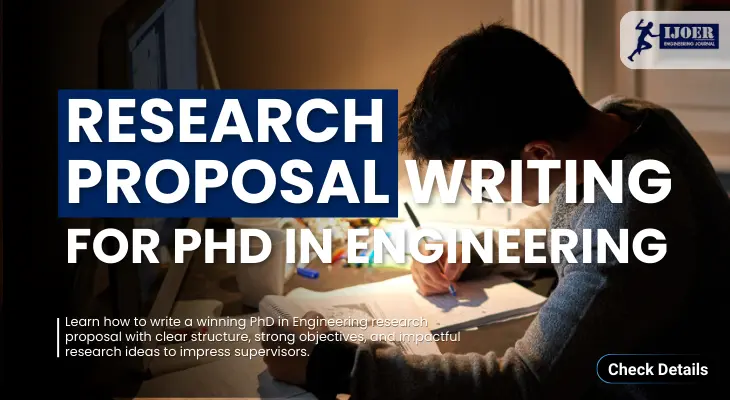
A PhD in Engineering is one of the highest academic achievements, allowing you to contribute original research and push the boundaries of technology. But before you can start your doctoral journey, you need one crucial document — a research proposal.
Your research proposal is not just a formality; it’s a roadmap that shows your university and potential supervisor that you have a clear, feasible, and significant research idea. This guide will walk you through everything you need to know about writing a winning research proposal for a PhD in Engineering.
A research proposal is a detailed plan of the study you want to undertake. It outlines:
For engineering, it’s often more technical than in other fields — including models, simulations, experimental setups, and sometimes a preliminary design framework.
A well-prepared research proposal:
Without a convincing proposal, even a great research idea might be overlooked.
While formats vary by university, most proposals include:
Keep it concise, specific, and descriptive. Example: "Development of AI-Based Predictive Models for Smart Grid Energy Optimization"
A short summary (150–250 words) covering your research problem, objectives, methods, and expected results.
Explain the background of your topic and why it’s important. Example: Discuss the growing demand for sustainable energy systems and how AI can optimize their efficiency.
Clearly state the research gap or challenge you aim to address. Avoid vague statements. Example: “Despite advances in smart grid systems, predictive models for real-time optimization remain limited in scalability and accuracy.”
List your main aim and 3–5 specific objectives. Example Objective: Develop a machine learning model to forecast energy demand with 95% accuracy.
Summarize recent studies, identify gaps, and justify how your research fills those gaps.
Explain how you will conduct your research:
Describe the potential results and how they will advance engineering knowledge.
Include a Gantt chart or a phase-wise breakdown (Year 1: literature review; Year 2: experiments; Year 3: analysis and thesis writing).
Use a consistent citation style (APA, IEEE, etc.).
A well-crafted PhD proposal can make the difference between acceptance and rejection. Keep these strategies in mind:
Even strong candidates can stumble if they overlook these pitfalls:
Writing a PhD research proposal in engineering is not just about filling in a template — it’s about presenting your vision for innovation in a clear, structured, and convincing way. With a strong proposal, you can demonstrate your readiness to tackle complex engineering challenges and make a lasting contribution to the field.
1. How long should a PhD engineering research proposal be?
Most universities require between 1,500 and 3,000 words (5–10 pages), excluding references and appendices. Always check your target university’s specific guidelines.
2. Do I need a finalized research topic before applying?
Yes, you need a clear topic and research question for your proposal, but it’s normal for the scope to evolve once you begin your PhD. Supervisors expect some refinement during the initial research phase.
3. Should I contact a supervisor before submitting my proposal?
It’s highly recommended. Reaching out to potential supervisors before applying can help you align your topic with their expertise and increase your chances of acceptance.
4. How technical should my proposal be?
Since this is engineering, your proposal should include technical details such as models, equations, simulation tools, or experimental methods. However, keep the language clear enough for reviewers from different engineering subfields to understand.
5. Do I need preliminary results for my proposal?
Preliminary results are not mandatory but can strengthen your application by showing feasibility and competence. Even small-scale pilot studies, simulations, or design sketches can make a difference.
6. Can I apply for a PhD in engineering with only a bachelor’s degree?
In some countries (like the USA), you can apply directly after a bachelor’s degree if you have an exceptional academic record and research experience. In others, a master’s degree is preferred or required.
7. How important is the literature review in my proposal?
Very important — it demonstrates that you understand the current state of research, can identify gaps, and are proposing something original and relevant.
8. Should I include a budget in my proposal?
If you’re applying for funding or a scholarship, yes. Outline costs for equipment, software licenses, materials, travel, and other research-related expenses.
9. Can I change my research topic after starting my PhD?
Minor changes are common, especially after the initial literature review, but major topic shifts may require supervisor approval and adjustments to funding or timelines.
10. How do I make my proposal stand out?
Focus on clarity, originality, feasibility, and impact. Align your proposal with current engineering challenges and highlight both academic and real-world benefits of your research.

|
Citation Indices
|
All
|
Since 2020
|
Citation |
2359 |
1680 |
h-index |
19 |
15 |
i10-index |
57 |
24 |
|
Acceptance Rate (By Year)
|
|
|
Year
|
Percentage
|
|
2023
|
9.64%
|
|
2027
|
17.64%
|
|
2022
|
13.14%
|
|
2021
|
14.26%
|
|
2020
|
11.8%
|
|
2019
|
16.3%
|
|
2018
|
18.65%
|
|
2017
|
15.9%
|
|
2016
|
20.9%
|
|
2015
|
22.5%
|